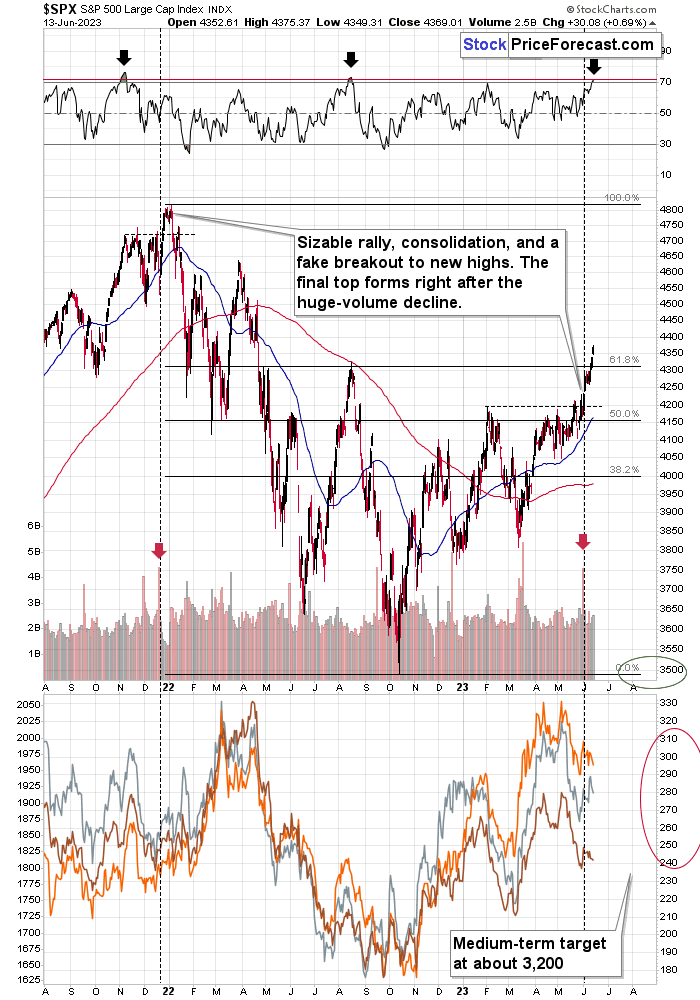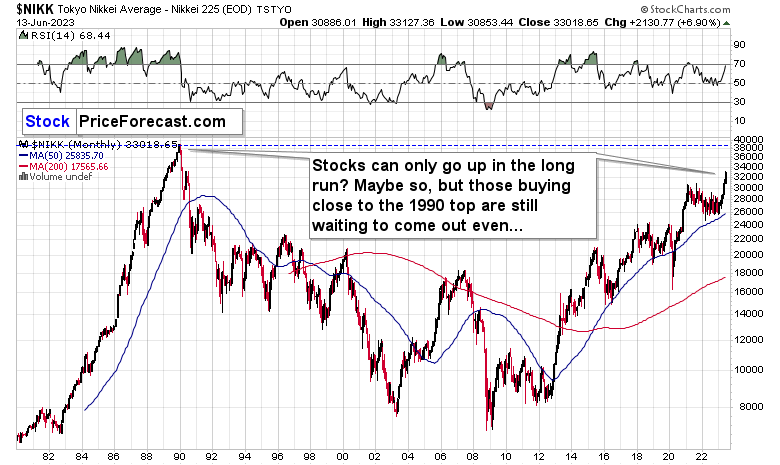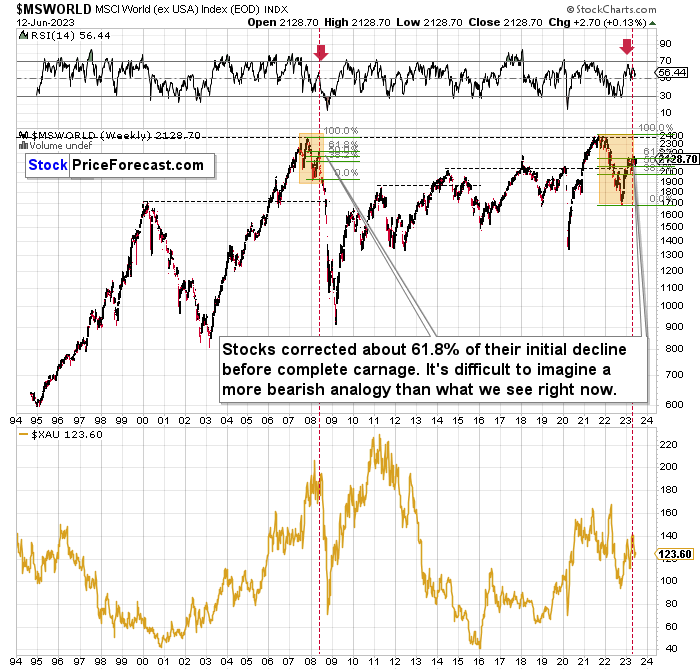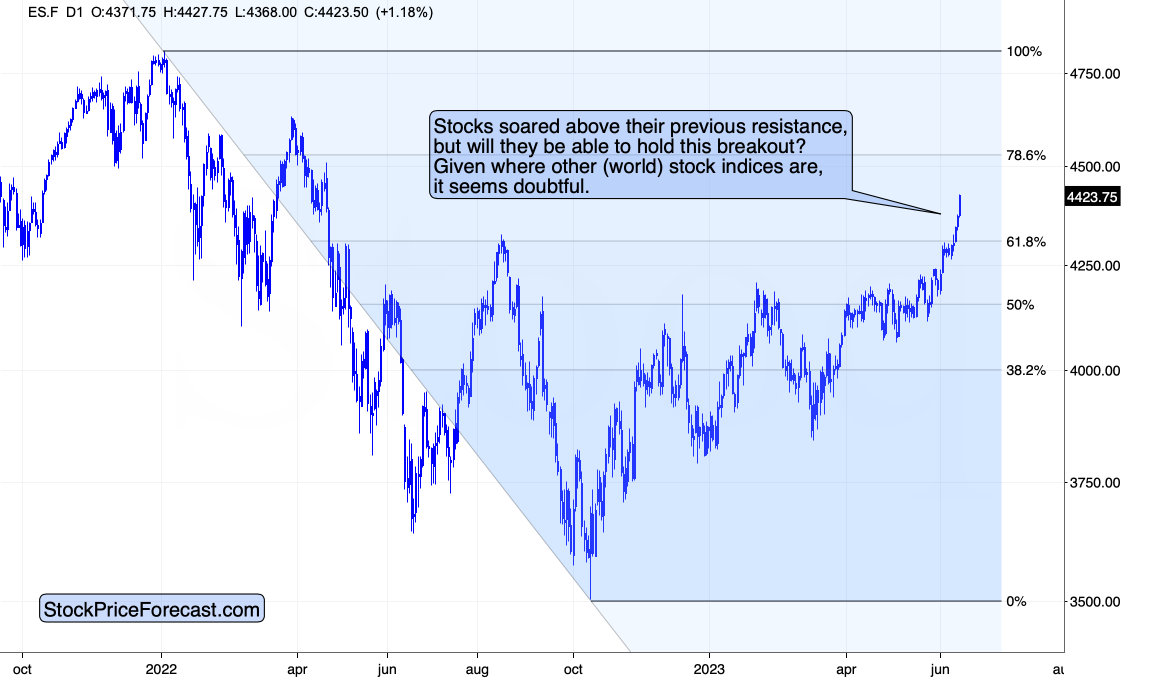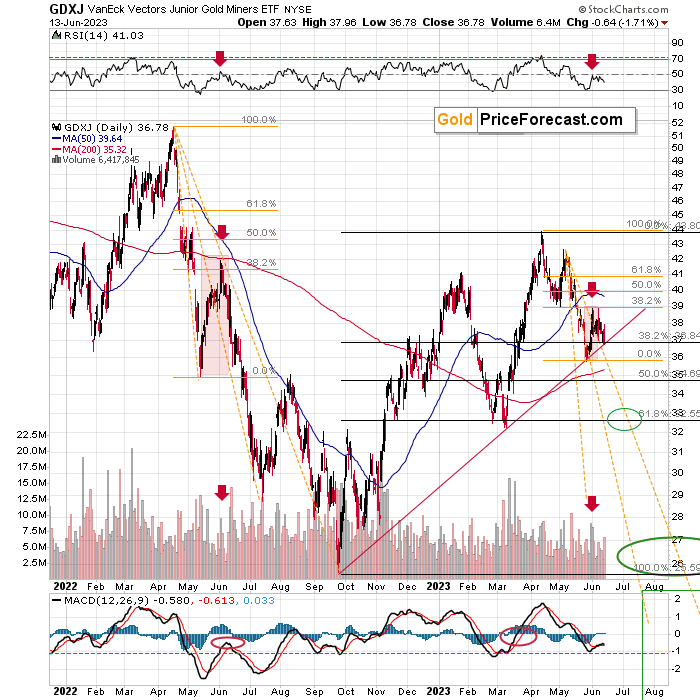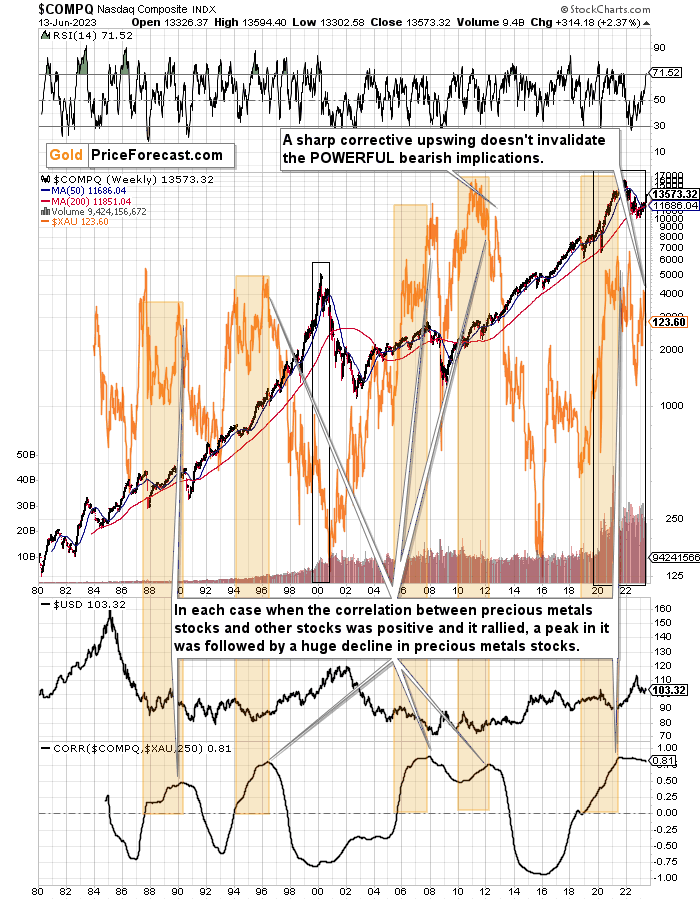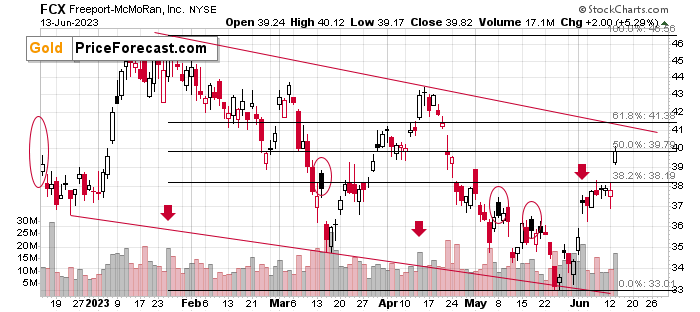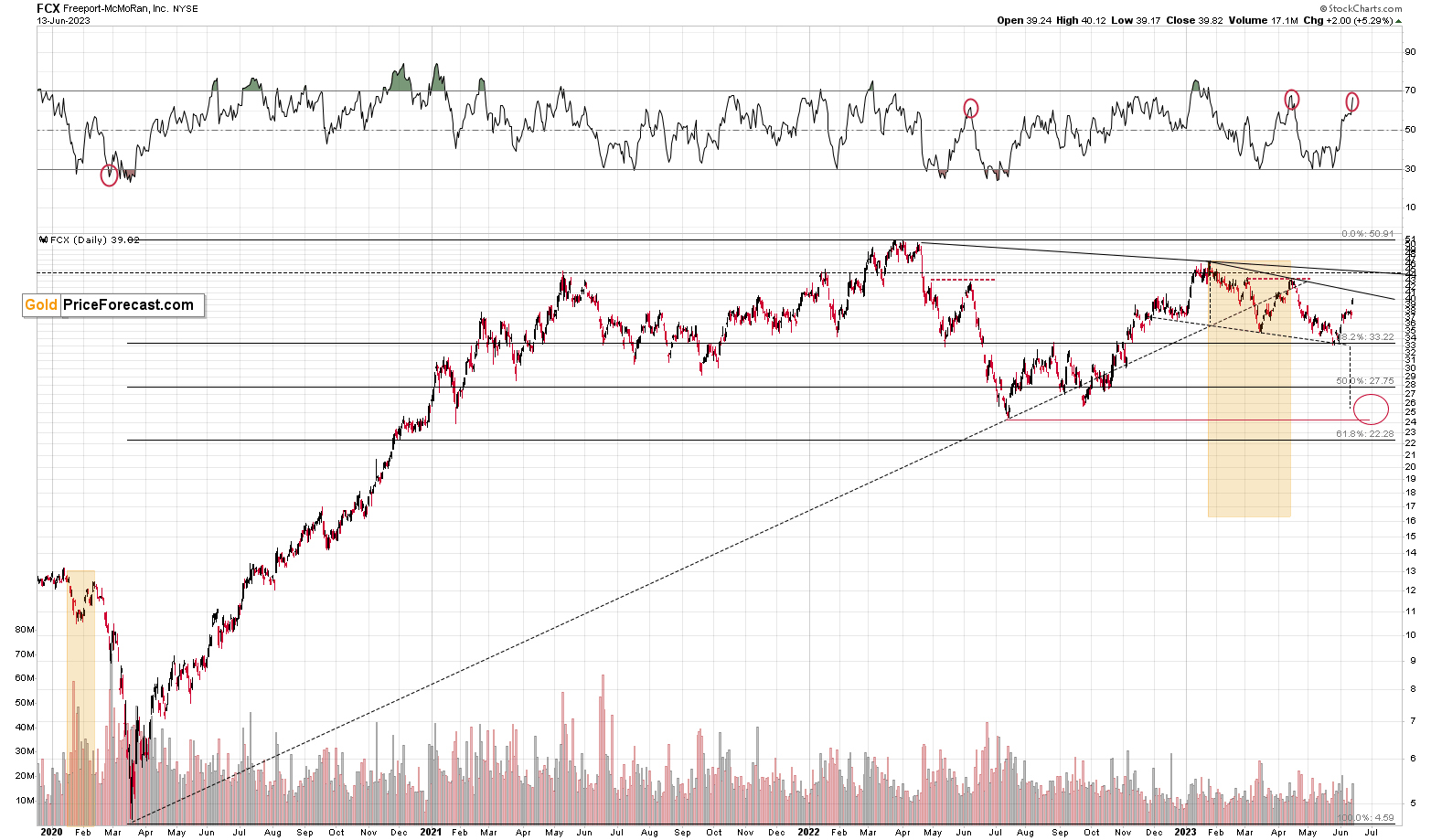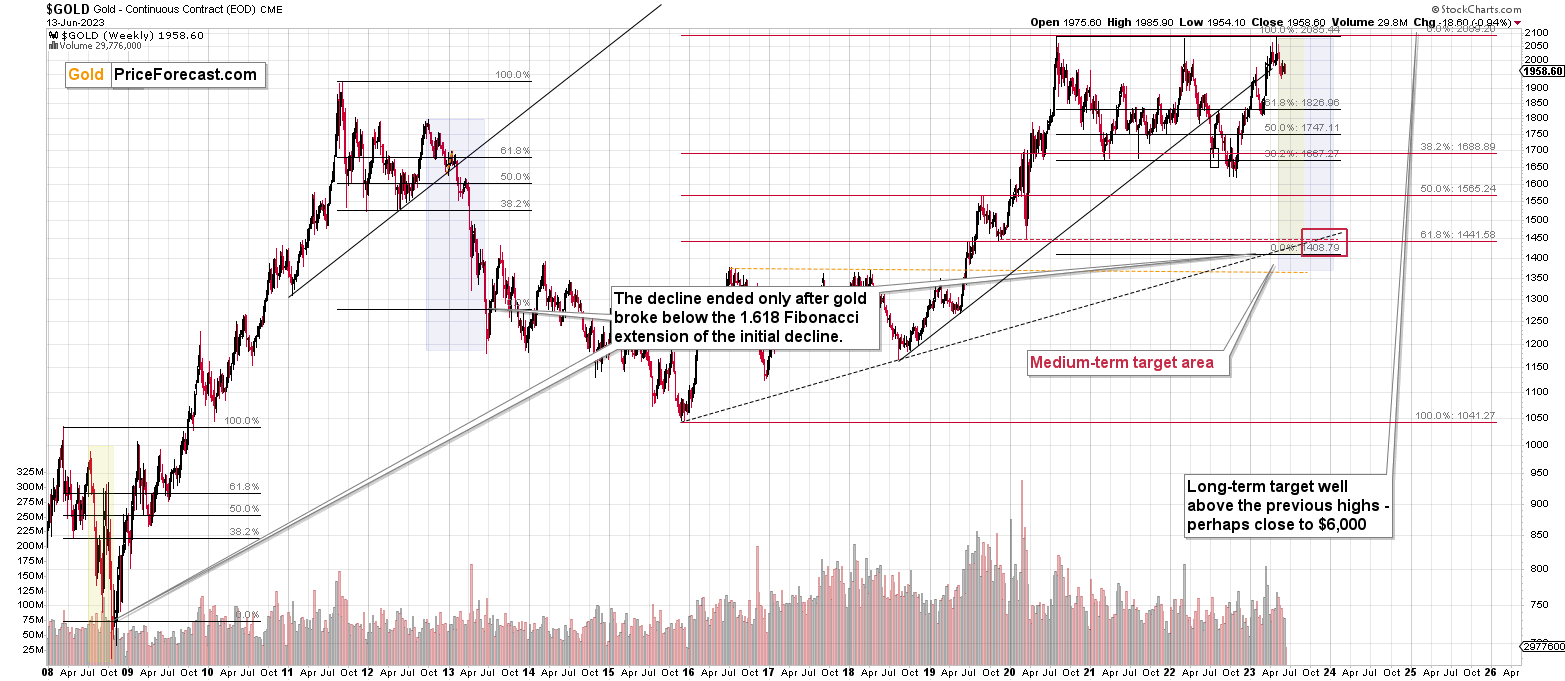Briefly: in our opinion, full (300% of the regular position size) speculative short positions in junior mining stocks are justified from the risk/reward point of view at the moment of publishing this Alert.
Some might consider an additional (short) position in the FCX.
Are stocks really invincible? Can they soar indefinitely as the Plunge Protection Team continues to save them? What are the implications for miners?
Stocks rallied. Again and again. Against quite many indications. Is this the only way in which they will move now?
Are the Powers That Be going to save stocks in all cases?
That’s what we heard not just once but many times in the past. You know when we definitely heard it?
In Japan in the late 80s and in mid-1990.
The Japanese stock market was after a huge, prolonged rally and after the initial move down. The late-1990 rally must have triggered a lot of “the rally is back; stocks are never going to fall profoundly” comments.
After seeing a rally this big, it was natural to expect it to continue. Everything was great right before, and it’s just a sharp correction, just like the one that we saw in the 1987… Right?
It turned out that this wasn’t the case, and The Powers That Be weren’t able to save the stock market. It finally bottomed many years later, in 2008.
The late-1990 rally was actually the “return to normalcy” stage of the bear market that, to many, still looked like the bull market.
And this market juncture makes it very difficult to stay calm and objective.
The “return to normalcy” stage is when the vast majority of market participants expect the previously unsustainable rally to be continued, even though much has changed and it’s already a different stage of the market. It’s no longer a bull market.
I’m writing about the stock market here, but the emotionality spreads to other markets as well. That’s most likely why people are not reacting to the massive increases in real interest rates as much as they “should”.
Where are we now in general? And by general, I mean globally.
We’re in a situation where stocks repeat their 2007-2008 performance.
Namely, world stocks corrected about 61.8% of their preceding decline, and that decline started from the same levels as the 2007/2008 one.
Please note that the initial decline is now bigger than what we saw in 2008. Back then, stocks corrected about 61.8% of their initial decline before tumbling. And exactly the same thing happened recently!
Also, the RSI just turned south and back in 2008; that was the final confirmation before the waterfall selling.
Just as the 2008 rally wasn’t bullish, the most recent corrective upswing wasn’t bullish at all.
Real interest rates are rising, which is bad news for businesses. People appear to live on “hopium,” expecting the Fed to turn dovish and throw money on the market, but the data doesn’t support this outcome at all.
Given the analogy to 2008 and the fact that the initial slide was bigger this time, the following slide could be even bigger than what we saw in 2008. Naturally, this would be profoundly bearish for junior mining stocks.
This means that nothing really changed, and the situation remains extremely bearish based, i.e., on the analogy to what we saw after previous invalidations of long-term breakouts.
As a reminder, in early 2022, I wrote that the situation was very bearish as invalidations of previous breakouts were usually followed by massive declines – not just in stocks but also in precious metals.
When stocks invalidated their 2006 breakout in 2008, their prices truly crumbled.
We also saw that on a smaller scale in 2014, 2015, and early 2018.
And we saw it recently.
To clarify, we’re actually seeing the aftermath of the invalidation. The huge decline is already taking place.
The difference between now and 2008 is that back then, the slide was more volatile, and we didn’t really see a visible correction during the plunge. This time, the decline is more measured, and we saw a correction to one of the most classic retracements imaginable – the 61.8% one. This correction doesn’t change the trend, which remains down.
Based on what happened in 2008, it seems that stocks are about to move much lower in the following months.
So… It looks like the “return to normal” is a global phenomenon.
Now, the above index excludes the U.S. markets, but… Can one really think that in today’s globalized economy, U.S. stocks can really be on their own while the rest of the world experiences declining stocks?
Here’s the U.S. stock market chart once again. The second chart features today’s overnight trading in the S&P 500 futures.
The S&P 500 futures soared in today’s overnight trading, but it is doubtful that they will be able to hold those gains given what’s happening in the rest of the world.
Plus, the RSI indicator that you can see on the above chart already moved above 70, and given today’s overnight move higher, it’s already in the extreme zone that stopped even the most profound rallies, including the one that we saw in mid-2022.
Is the stock market soaring in hopes of seeing a rate cut based on the AI-world-changing narrative? That’s quite possible. After all, the investment public that likely drives the market right now is not known for rational decisions.
It could be the case that we see a big reversal close to or after today’s interest rate decision and the following press conference.
And what does it all mean for the junior mining stocks?
It’s not even close to being as bullish as one might think.
If stocks continue to move higher, junior miners are likely to decline anyway, just like they did yesterday.
Junior miners moved to a new monthly low yesterday. That happened while the S&P 500 moved higher.
If junior miners don’t get that extra push from stocks, they would be likely to decline, anyway.
But when juniors finally do get that extra bearish push, they are likely to truly plunge.
That’s what happened in 2020, and that’s what happened in 2008. And that’s what’s likely to happen this year. In fact, the yearly top is most likely already in, and we are already in the medium-term decline.
One more note regarding the stock market and the AI hype. Please note that we’ve already seen this before. It was a long time ago – during the dot-com bubble, but the final implications are analogous.
In the recent flagship Gold Trading Alert, I wrote the following:
Just look at the NASDAQ chart and take just a second or two to compare the 90s rally with what we saw recently.
They’re very similar, and it’s clear at the first sight.
This time the volatility wasn’t as big, so it’s no wonder that the final top, initial decline and then the correction took more time. I marked both periods with black rectangles.
The rectangle covers volume and that’s not accidental. The action in it confirms that the situations are indeed analogous. The final tops formed on volume that increased rapidly, then it declined along with prices, and it stayed stable during the final pre-slide correction. That had been the case in 1999 / 2000, and it was the case in the recent months, weeks, and days.
Back in 2000, tech stocks declined and mining stocks (XAU Index is a proxy for gold and silver mining stocks and it’s marked with orange on the above chart) moved higher, but that was when those two markets had been negatively correlated in the long run (based on the 250-session correlation coefficient that you can see at the bottom of the above chart).
The correlation has been positive for a long time now, which means that when tech stocks slide now, they are likely to take mining stocks with them.
And are tech stocks likely to tumble soon?
Yes! That’s what the analogy to the Dot-com bubble and all above-mentioned signs point to.
Moreover, please note that the 50-week moving average (marked with blue) has almost always been on the rise. In the recent decades there were only three times when this moving average turned down in a noticeable way.
- One was at the 2000 top.
- Second warned about the 2008 slide.
- The third time was earlier this year.
Is this time different?
No, it isn’t. Tech stocks are about to slide, and mining stocks are likely to slide along with them.
But wait, there’s more!
The orange rectangles on the above chart mark times between the moment when the long-term mining-stocks-other-stocks correlation turned positive right to its top.
The particularly interesting thing is that when the correlation topped, it was only a matter of time before huge declines in the XAU Index followed.
That worked in four out of all four cases that we saw in the previous decades. And, in fact, ever, because the XAU Index didn’t exist before mid-80s.
And we saw this indication also in the previous months. Since that time, we saw a sizable decline and a corrective upswing that’s similar to the one that we saw in 2012. Since the 2012 rally wasn’t able to reverse the massive bearish indication, the recent one most likely wasn’t able to achieve that, either.
What followed the 2012 corrective upswing? A powerful slide. One that was in tune with the previous huge declines that we saw after the long-term correlation peaks.
The history is likely to rhyme, as above-featured German philosopher Georg Hegel pointed it out – people don’t learn from history.
At least most of them. And this “most” is the same “most” that is not making money in the long run.
Don’t be among those “most”.
What does it all mean in the short run?
Truth be told, it doesn’t have any very short-term implications, as it tells us how enormous the decline in mining stocks is likely to be in the following months, but as far as the day-to-day performance is concerned, more short-term charts are needed to estimate what’s the likely course of action.
All in all, the situation in stocks is not as bullish as it seems at first sight. Please remember that “bullish” and “bearish” relates to the outlook and not to something that just (or recently) happened. Looking at the situation from the global point of view and taking into account more than just the recent price performance (situation in tech stocks, technical indicators, overall sentiment, and analogy to bull/bear market stages) is likely to provide a much better overview and thus help one construct better forecasts. And at this time, the above suggests that the next big move in stocks is going to be to the downside.
The implications for the precious metals sector are between neutral (if stocks continue to rally) to extremely bearish (when stocks finally decline).
Meanwhile, the corrective rally in the FCX is bigger than what I originally expected.
FCX moved higher yesterday, likely due to a dovish move in China, but it’s unlikely that this move will change the long-term downtrend.
This is the second corrective upswing within the decline that started in early 2023, but that is part of a broader downswing that started in 2022.
Interestingly, the entire 2022-now performance could be viewed as the right should of a head and shoulders formation, so something symmetrical to the left shoulder that was created by the 2021 upswing and correction. The recent move higher doesn’t invalidate the symmetry of the pattern, so it has a very good chance of forming.
Now, on a very short-term basis, FCX might have topped here, or it might move to its next Fibonacci retracement, which coincides with the declining resistance line. If this level is reached (a bit below $42), it will very likely mark the top. This might be a good moment for one to add to their short positions in the FCX.
And just as the stock market is likely headed much lower – not just the U.S. stock market, but in particular world stocks, the demand for copper and the value of shares of its producers (like FCX) is likely to decline.
Therefore, the very bearish outlook for both: GDXJ and FCX remains intact.
PS. To clarify some confusion and misleading information that you might find “out there” (probably spread by those that are not analyzing the precious metals market but that rather cheerleading it) regarding my profitability and the kind of positions that I’m opening in my Gold Trading Alerts (both: long and short), here’s a complete (!) list of trades that I featured since 2022.
Whenever discussing profits, I mean the nominal profits based on the basic, unleveraged instrument, like GDXJ and FCX); selection of instruments is not something I’m accountable for, and each investor determines it on their own, thus I’m not responsible for using options, leveraged instruments like futures / leveraged ETFs etc., and the way it might affect the rate of return.
Yes, all eight out of eight were profitable. And while I can’t promise any kind of performance of the current positions (nor any other), in my opinion, their potential is enormous.
Here’s the complete (!) list in inverse chronological order (please click the links for the actual analyses in which I described when the profits were taken; feel free to verify hours at which it was posted and where markets were trading at those times):
1. On May 25, 2023 we took profits from the short position in the FCX (practically right at the bottom; opened on Apr. 5, 2023).
2. On Mar. 17, 2023 we took profits from the short position in the FCX (almost right at the bottom; opened on Mar. 8, 2023).
3. On Mar. 1, 2023 we took profits from the LONG position in the GDXJ (very close to the local bottom; after the “easy part” of the rally).
4. On Feb. 24, 2023 we took profits from the short position in the GDXJ (almost right at the bottom; and that’s where I wrote about the long position from point 3).
5. On Jul. 28, 2022 we took profits from the LONG position in the GDXJ (entered on Jul. 11, 2022; we were buying around and very close to the bottom).
6. On Jul. 8, 2022 we took profits from the short position in the GDXJ (very close to the bottom).
7. On May 26, 2022 we took profits from the LONG position in the GDXJ (very close to the top; just several days before the top).
8. On May 12, 2022 we took profits from the short position in the GDXJ (that was exactly the monthly low and reversal; and that’s where I wrote about the long position from point 7).
Overview of the Upcoming Part of the Decline
- It seems that the recent – and probably final – corrective upswing in the precious metals sector is over.
- If we see a situation where miners slide in a meaningful and volatile way while silver doesn’t (it just declines moderately), I plan to – once again – switch from short positions in miners to short positions in silver. At this time, it’s too early to say at what price levels this could take place and if we get this kind of opportunity at all.
- I plan to switch from the short positions in junior mining stocks or silver (whichever I’ll have at that moment) to long positions in junior mining stocks when gold / mining stocks move to their 2020 lows (approximately). While I’m probably not going to write about it at this stage yet, this is when some investors might consider getting back in with their long-term investing capital (or perhaps 1/3 or 1/2 thereof).
- I plan to return to short positions in junior mining stocks after a rebound – and the rebound could take gold from about $1,450 to about $1,550, and it could take the GDXJ from about $20 to about $24. In other words, I’m currently planning to go long when GDXJ is close to $20 (which might take place when gold is close to $1,450), and I’m planning to exit this long position and re-enter the short position once we see a corrective rally to $24 in the GDXJ (which might take place when gold is close to $1,550).
- I plan to exit all remaining short positions once gold shows substantial strength relative to the USD Index while the latter is still rallying. This may be the case with gold prices close to $1,400 and GDXJ close to $15 . This moment (when gold performs very strongly against the rallying USD and miners are strong relative to gold after its substantial decline) is likely to be the best entry point for long-term investments, in my view. This can also happen with gold close to $1,400, but at the moment it’s too early to say with certainty.
- The above is based on the information available today, and it might change in the following days/weeks.
You will find my general overview of the outlook for gold on the chart below:
Please note that the above timing details are relatively broad and “for general overview only” – so that you know more or less what I think and how volatile I think the moves are likely to be – on an approximate basis. These time targets are not binding nor clear enough for me to think that they should be used for purchasing options, warrants, or similar instruments.
Letters to the Editor
Please post your questions in the comments feed below the articles, if they are about issues raised within the article (or in the recent issues). If they are about other, more universal matters, I encourage you to use the Ask the Community space (I’m also part of the community), so that more people can contribute to the reply and enjoy the answers. Of course, let’s keep the target-related discussions in the premium space (where you’re reading this).
Summary
To summarize, the medium-term outlook for the precious metals sector (and for the FCX) remains to be extremely bearish and the profit potential for the current short positions in junior miners and FCX remains enormous.
While I can’t promise any kind of return (nobody can), in my opinion, the recent profitable position in the FCX will soon be joined by even more profits from the current positions in GDXJ and FCX, and the winning streak of trades that started in early 2022, will continue.
If I didn’t have a short position in junior mining stocks, I would be entering it now.
As always, we'll keep you – our subscribers – informed.
To summarize:
Trading capital (supplementary part of the portfolio; our opinion): Full speculative short positions (300% of the full position) in junior mining stocks are justified from the risk to reward point of view with the following binding exit profit-take price levels:
Mining stocks (price levels for the GDXJ ETF): binding profit-take exit price: $26.13; stop-loss: none.
Alternatively, if one seeks leverage, we’re providing the binding profit-take levels for the JDST (2x leveraged). The binding profit-take level for the JDST: $13.87; stop-loss for the JDST: none.
For-your-information targets (our opinion; we continue to think that mining stocks are the preferred way of taking advantage of the upcoming price move, but if for whatever reason one wants / has to use silver or gold for this trade, we are providing the details anyway.):
Silver futures downside profit-take exit price: $17.83 (stop-loss: none)
SLV profit-take exit price: $16.73 (stop-loss: none)
ZSL profit-take exit price: $32.97 (stop-loss: none)
Gold futures downside profit-take exit price: $1,743 (stop-loss: none)
HGD.TO – alternative (Canadian) 2x inverse leveraged gold stocks ETF – the upside profit-take exit price: $10.97 (stop-loss: none due to vague link in the short term with the U.S.-traded GDXJ)
HZD.TO – alternative (Canadian) 2x inverse leveraged silver ETF – the upside profit-take exit price: $25.47 (stop-loss: none)
///
Optional / additional trade idea that I think is justified from the risk to reward point of view:
Short position in the FCX with $27.13 as the short-term profit-take level.
Long-term capital (core part of the portfolio; our opinion): No positions (in other words: cash)
Insurance capital (core part of the portfolio; our opinion): Full position
Whether you’ve already subscribed or not, we encourage you to find out how to make the most of our alerts and read our replies to the most common alert-and-gold-trading-related-questions.
Please note that we describe the situation for the day that the alert is posted in the trading section. In other words, if we are writing about a speculative position, it means that it is up-to-date on the day it was posted. We are also featuring the initial target prices to decide whether keeping a position on a given day is in tune with your approach (some moves are too small for medium-term traders, and some might appear too big for day-traders).
Additionally, you might want to read why our stop-loss orders are usually relatively far from the current price.
Please note that a full position doesn't mean using all of the capital for a given trade. You will find details on our thoughts on gold portfolio structuring in the Key Insights section on our website.
As a reminder - "initial target price" means exactly that - an "initial" one. It's not a price level at which we suggest closing positions. If this becomes the case (as it did in the previous trade), we will refer to these levels as levels of exit orders (exactly as we've done previously). Stop-loss levels, however, are naturally not "initial", but something that, in our opinion, might be entered as an order.
Since it is impossible to synchronize target prices and stop-loss levels for all the ETFs and ETNs with the main markets that we provide these levels for (gold, silver and mining stocks - the GDX ETF), the stop-loss levels and target prices for other ETNs and ETF (among other: UGL, GLL, AGQ, ZSL, NUGT, DUST, JNUG, JDST) are provided as supplementary, and not as "final". This means that if a stop-loss or a target level is reached for any of the "additional instruments" (GLL for instance), but not for the "main instrument" (gold in this case), we will view positions in both gold and GLL as still open and the stop-loss for GLL would have to be moved lower. On the other hand, if gold moves to a stop-loss level but GLL doesn't, then we will view both positions (in gold and GLL) as closed. In other words, since it's not possible to be 100% certain that each related instrument moves to a given level when the underlying instrument does, we can't provide levels that would be binding. The levels that we do provide are our best estimate of the levels that will correspond to the levels in the underlying assets, but it will be the underlying assets that one will need to focus on regarding the signs pointing to closing a given position or keeping it open. We might adjust the levels in the "additional instruments" without adjusting the levels in the "main instruments", which will simply mean that we have improved our estimation of these levels, not that we changed our outlook on the markets. We are already working on a tool that would update these levels daily for the most popular ETFs, ETNs and individual mining stocks.
Our preferred ways to invest in and to trade gold along with the reasoning can be found in the how to buy gold section. Furthermore, our preferred ETFs and ETNs can be found in our Gold & Silver ETF Ranking.
As a reminder, Gold & Silver Trading Alerts are posted before or on each trading day (we usually post them before the opening bell, but we don't promise doing that each day). If there's anything urgent, we will send you an additional small alert before posting the main one.
===
On a side note, while commenting on analyses, please keep the Pillars of the Community in mind. It’s great to provide points that help others be more objective. However, it’s important to focus on the facts and discuss them in a dignified manner. There is not much of the latter in personal attacks. As more and more people join our community, it is important to keep it friendly. Being yourself, even to the point of swearing, is great, but the point is not to belittle other people or put them in a position of “shame” (whether it works or not). Everyone can make mistakes, and everyone does, in fact, make mistakes. We all here have the same goal: to have a greater understanding of the markets and pick better risk-to-reward situations for our trades. We are on the same side.
On another – and final – side note, the number of messages, comments etc. that I’m receiving is enormous, and while I’m grateful for such engagement and feedback, I’m also starting to realize that there’s no way in which I’m going to be able to provide replies to everyone that I would like to, while keeping any sort of work-life balance and sanity ;) Not to mention peace of mind and calmness required to approach the markets with maximum objectivity and to provide you with the service of the highest quality – and best of my abilities.
Consequently, please keep in mind that I will not be able to react / reply to all messages. It will be my priority to reply to messages/comments that adhere to the Pillars of the Community (I wrote them, by the way) and are based on kindness, compassion and on helping others grow themselves and their capital in the most objective manner possible (and to messages that are supportive in general). I noticed that whatever one puts their attention to – grows, and that’s what I think all communities need more of.
Sometimes, Golden Meadow’s support team forwards me a message from someone, who assumed that I might not be able to see a message on Golden Meadow, but that I would notice it in my e-mail account. However, since it’s the point here to create a supportive community, I will specifically not be providing any replies over email, and I will be providing them over here (to the extent time permits). Everyone’s best option is to communicate here, on Golden Meadow, ideally not in private messages (there are exceptions, of course!) but in specific spaces or below articles, because even if I’m not able to reply, the odds are that there will be someone else with insights on a given matter that might provide helpful details. And since we are all on the same side (aiming to grow ourselves and our capital), a to of value can be created through this kind of collaboration :).
Thank you.
Przemyslaw K. Radomski, CFA
Founder, Editor-in-chief


